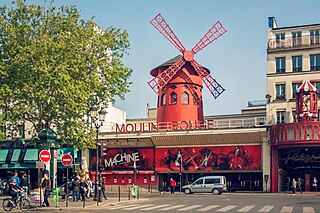
Moulin Rouge is a cabaret in Paris, on Boulevard de Clichy, at Place Blanche, the intersection of, and terminus of Rue Blanche.

Comte Henri Marie Raymond de Toulouse-Lautrec-Monfa was a French painter, printmaker, draughtsman, caricaturist and illustrator whose immersion in the colourful and theatrical life of Paris in the late 19th century allowed him to produce a collection of enticing, elegant, and provocative images of the sometimes decadent affairs of those times.

The can-can is a high-energy, physically demanding dance that became a popular music-hall dance in the 1840s, continuing in popularity in French cabaret to this day. Originally danced by couples, it is now traditionally associated with a chorus line of female dancers. The main features of the dance are the vigorous manipulation of skirts and petticoats, along with high kicks, splits, and cartwheels.

Moulin Rouge is a 1952 British drama film, written and directed by John Huston, based on the 1950 novel by Pierre La Mure, and produced by John and James Woolf. The film follows artist Henri de Toulouse-Lautrec in 19th-century Paris's bohemian subculture in and around the Moulin Rouge, a burlesque palace. The film was screened at the 14th Venice International Film Festival, where it won the Silver Lion.

Jules Chéret was a French painter and lithographer who became a master of Belle Époque poster art. He has been called the father of the modern poster.
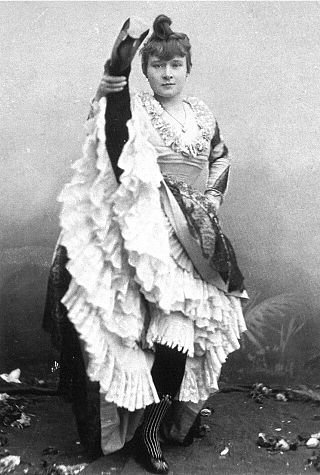
La Goulue, was the stage name of Louise Weber, a French can-can dancer who was a star of the Moulin Rouge, a popular cabaret in the Pigalle district of Paris, near Montmartre. Weber became known as La Goulue because as an adolescent, she was known for guzzling cabaret patrons' drinks while dancing. She also was referred to as the Queen of Montmartre.

Jane Avril was a French can-can dancer made famous by Henri de Toulouse-Lautrec through his paintings. Extremely thin, "given to jerky movements and sudden contortions", she was nicknamed La Mélinite, after an explosive.

At the Moulin Rouge is an oil-on-canvas painting by French artist Henri de Toulouse-Lautrec. It was painted between 1892 and 1895. Included in the background is a self-portrait of the artist in profile. It is one of a number of works by Toulouse-Lautrec depicting the Moulin Rouge cabaret built in Paris in 1889.
Louis Auguste Mathieu Legrand was a French artist, known especially for his aquatint engravings, which were sometimes erotic. He was awarded the Légion d'honneur for his work in 1906.

Maxime-Pierre Jules Dethomas was a French painter, draughtsman, printmaker, illustrator, and was among the best known theater-set and costume designers of his era. As an artist, Dethomas was highly regarded by his contemporaries and exhibited widely, both within France and abroad. He was a regular contributor to the Impressionistes et Symbolistes, and a founding committee member of the Salon d'Automne. In 1912, he was awarded the Chevalier de la Légion d'honneur for his contributions to French art.
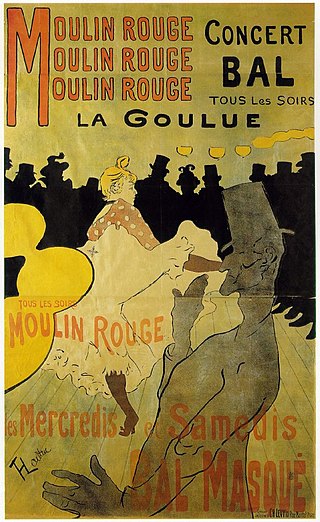
Valentin le Désossé was the stage name of Jacques Renaudin, a French can-can dancer who was a star of the Moulin Rouge in the 1890s as the partner of Louise Weber, known as La Goulue.

Henri-Gabriel Ibels was a French illustrator, printmaker, painter and author.

Alfred Choubrac was a French painter, illustrator, draughtsman, poster artist and costume designer. Together with Jules Chéret he is considered to be one of the pioneers of the modern coloured and illustrated poster of the Belle Époque in France, in particular in Paris.
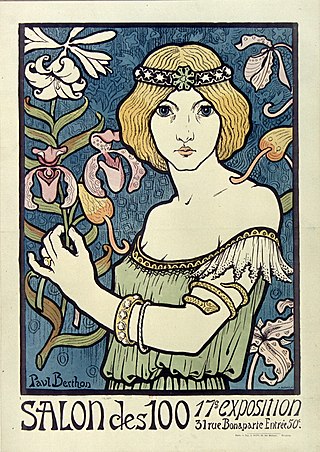
Salon des Cent was a commercial art exhibition in Paris, based at 31 Rue Bonaparte. The Salon sold color posters, prints and reproductions of artwork to the general public at reasonable prices. It was established in February 1894 by Léon Deschamps, founder of La Plume an avant garde literary and artistic magazine. It became known for its exhibitions showcasing the works of contemporary graphical artists. The salon held exhibitions until 1900. Many of the posters advertising Salon des Cent exhibitions have themselves become collectors' items.
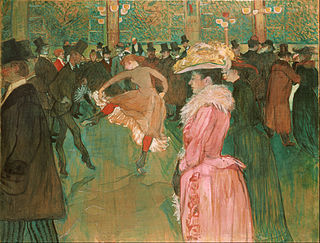
At the Moulin Rouge, the Dance is an oil-on-canvas painted by French artist Henri de Toulouse-Lautrec. It was painted in 1890, and is the second of a number of graphic paintings by Toulouse-Lautrec depicting the Moulin Rouge cabaret built in Paris in 1889. It portrays two dancers dancing the can-can in the middle of the crowded dance hall. A recently discovered inscription by Toulouse-Lautrec on the back of the painting reads: "The instruction of the new ones by Valentine the Boneless." This means that the man to the left of the woman dancing, is Valentin le désossé, a well-known dancer at the Moulin Rouge, and he is teaching the newest addition to the cabaret. To the right, is a mysterious aristocratic woman in pink. The background also features many aristocratic people such as poet Edward Yeats, the club owner and even Toulouse-Lautrec's father. The work is currently displayed at the Philadelphia Museum of Art.

Cha-U-Kao was a French entertainer who performed at the Moulin Rouge and the Nouveau Cirque in the 1890s. Her stage name was also the name of a boisterous popular dance, similar to the can-can, which came from the French words "chahut", meaning "noise" and "chaos". She was depicted in a series of paintings by Henri de Toulouse-Lautrec. Cha-U-Kao soon became one of his favorite models. The artist was fascinated by this woman who dared to choose the classic male profession of clowning and was not afraid to openly declare that she was a lesbian.

Divan Japonais is a lithograph poster by French artist Henri de Toulouse-Lautrec. It was created to advertise a café-chantant that was at the time known as Divan Japonais. The poster depicts three persons from the Montmartre of Toulouse-Lautrec's time. Dancer Jane Avril is in the audience. Beside her is writer Édouard Dujardin. They are watching a performance by Yvette Guilbert. Though her face is not included in the poster, she is recognizable by her tall, thin frame and long black gloves.

Désiré Dihau was a French bassoonist and composer. He was the bassoonist painted by Edgar Degas in L'Orchestre de l'Opéra with the cellist Louis-Marie Pilet seated behind him.
Lautrec is a 1998 French biographical film about the painter Henri de Toulouse-Lautrec. The film focuses on his love affair with painter Suzanne Valadon.

The Englishman at the Moulin Rouge is a late-19th-century painting by French artist Henri de Toulouse-Lautrec. Done in oil on cardboard, the work depicts British artist William T. Warrener – a close friend of Lautrec – and two women at the Moulin Rouge cabaret in Paris. The painting served as a preparatory study for a color lithograph of 1892, and is in the collection of the Metropolitan Museum of Art, which acquired it in 1967.


















